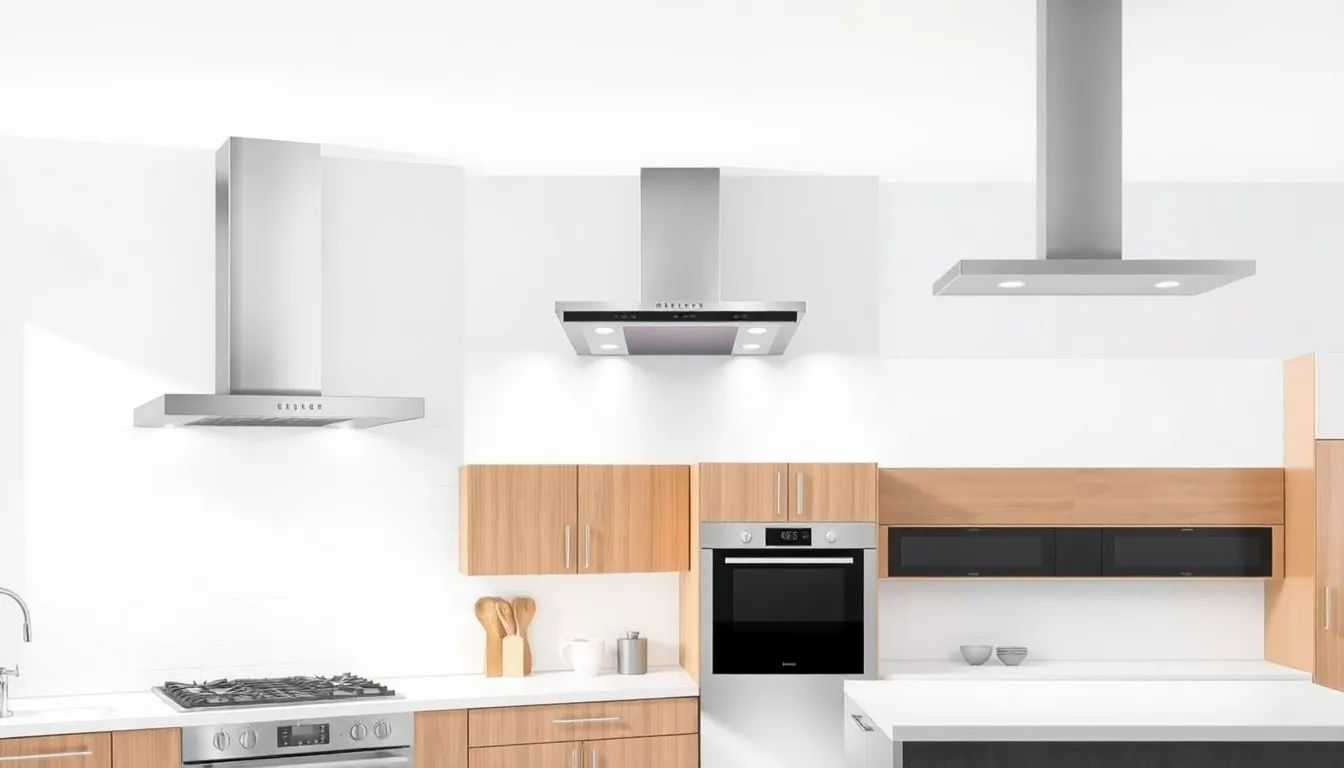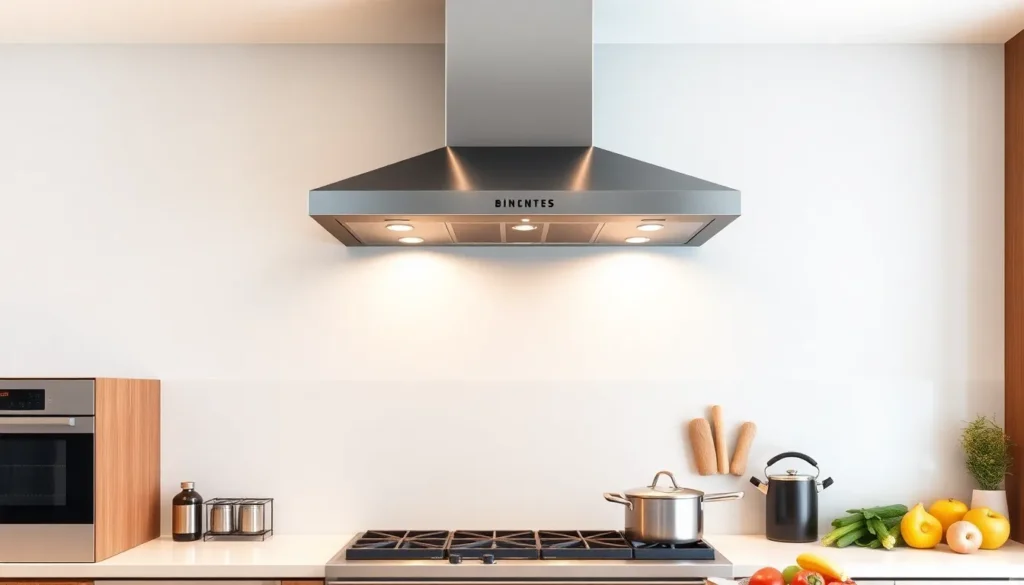Table of Contents
ToggleIn the culinary world, a range hood is like a superhero in disguise. It quietly swoops in to save the day, banishing smoke and odors while you whip up your latest masterpiece. Without it, your kitchen would resemble a scene from a cooking disaster movie, complete with lingering smells and greasy walls. Who needs that kind of drama when you can have a stylish, efficient range hood taking care of business?
Overview of Range Hoods
Range hoods play a crucial role in kitchen ventilation. They effectively capture and remove smoke, steam, and odors generated during cooking. Utilizing a range hood keeps kitchen air clean and aids in maintaining overall air quality.
Several types of range hoods exist, including wall-mounted, under-cabinet, and island models. Wall-mounted options serve as aesthetic focal points while offering powerful ventilation. Under-cabinet hoods fit seamlessly into existing cabinet structures, maximizing space and efficiency. Island hoods, designed for kitchens with central cooking areas, provide both function and style.
Range hoods come equipped with various features to enhance performance. Many models include multiple fan speeds, enabling users to adjust ventilation to match cooking intensity. Lighting features, such as LED lights, improve visibility on the cooking surface. Some advanced units feature noise reduction technology for quieter operation.
When selecting a range hood, consider the kitchen’s size and layout. Proper airflow requirements depend on the heat output of the cooking appliances. The recommendation for adequate CFM (cubic feet per minute) of ventilation often stands at 100 CFM for every 10,000 BTUs of heat output from the stovetop.
Stylish designs exist to complement diverse kitchen aesthetics. From modern stainless steel to classic copper finishes, range hoods can match various interior styles. Investing in a high-quality range hood not only enhances functionality but also adds visual appeal to the kitchen space.
Maintenance of range hoods is essential for optimal performance. Regular cleaning of filters and surfaces prevents grease buildup and ensures effective operation. Following manufacturer guidelines for maintenance helps prolong the unit’s lifespan and efficiency.
Types of Range Hoods

Range hoods come in various styles, each designed to suit specific kitchen layouts and preferences. Understanding these types helps in making informed choices for ventilation needs.
Wall-Mounted Range Hoods
Wall-mounted range hoods mount directly to the wall above the cooktop. These models save counter space while providing powerful ventilation. Many have a sleek design that delivers aesthetic appeal alongside functionality. Options with variable fan speeds effectively cater to different cooking intensities. Installation often requires proper height adjustments for optimal performance, typically between 24 to 30 inches above the cooktop.
Under-Cabinet Range Hoods
Under-cabinet range hoods fit neatly beneath kitchen cabinets, maximizing space efficiency. This type blends seamlessly into cabinetry, maintaining a streamlined look. Various sizes accommodate different ranges and kitchen dimensions. They often feature filters that require periodic cleaning or replacement for consistent efficiency. When choosing, consider a model that matches the cabinet’s finish to enhance overall kitchen design.
Island Range Hoods
Island range hoods hang above a kitchen island, creating a focal point while offering effective ventilation. These models often come in bold designs, showcasing creativity and flair. Many include advanced features such as lighting and digital controls for user convenience. Height and suspension requirements vary, typically ranging from 28 to 36 inches above the cooking surface. This type of hood suits open floor plans, offering both practicality and style in a kitchen layout.
Key Features to Consider
When choosing a range hood, several key features influence performance and aesthetics. Understanding these aspects ensures a suitable fit for any kitchen.
Ventilation Options
Several ventilation options exist for range hoods. Ducted models expel air outside, providing superior odor and smoke removal. Ductless versions, on the other hand, filter air through charcoal before recirculating it, making them suitable for spaces lacking exterior ductwork. Additionally, integrated models combine both methods, offering flexibility based on kitchen layout and preferences. The choice among these options significantly impacts overall efficiency and air quality.
Noise Levels
Noise levels of range hoods vary widely. Manufacturers list decibel ratings, indicating how loud each model operates. Quieter models typically operate around 40 decibels, similar to a library’s noise, while noisier ones may reach 70 decibels, akin to an active conversation. Noise can distract during cooking and dining, making it essential to consider sound levels during selection. Ideally, a balance between powerful ventilation and acceptable noise should guide the decision.
Design and Aesthetics
Design and aesthetics play a significant role in choosing a range hood. Styles range from sleek and modern to classic and ornate, accommodating diverse kitchen themes. Finishes such as stainless steel or matte black add visual appeal, while size and shape should complement existing cabinetry and features. A well-chosen range hood not only enhances functionality but also serves as an attractive focal point in the kitchen. Prioritizing design ensures a cohesive and inviting atmosphere.
Benefits of Installing Range Hoods
Installing range hoods offers several key advantages that improve kitchen environments. They effectively eliminate smoke, steam, and strong odors that often arise during cooking. Kitchen air remains fresh and enjoyable, reducing the risk of lingering smells.
Noise reduction technology contributes to a more pleasant cooking experience. Quieter models operate around 40 decibels, allowing for comfortable conversation while cooking. Ducted range hoods expel air outside, providing superior ventilation compared to ductless options.
Energy efficiency is another significant benefit. Most range hoods use less energy, translating to lower utility bills. Choosing LED lighting enhances visibility while cooking, adding functionality to the unit.
Design aesthetics play a crucial role in decision-making. Stylish range hoods elevate kitchen decor and serve as a focal point. Various finishes, such as stainless steel or custom cabinetry, allow seamless integration into diverse kitchen designs.
Regular maintenance ensures optimal performance and longevity. Simple cleaning steps keep filters and surfaces free from grease buildup. Efficiently functioning range hoods last longer and operate more effectively, adding to their overall value.
Improving indoor air quality becomes another important benefit. Clean air promotes better eye, skin, and respiratory health for those spending time in the kitchen. Eliminating pollutants like carbon monoxide and particulates also enhances overall home safety.
Customizing ventilation options further enhances functionality. Models with adjustable fan speeds allow control based on cooking intensity. That flexibility caters to various cooking styles and preferences.
Overall, range hoods significantly enhance kitchen functionality and aesthetics, positively impacting the cooking experience.
Maintenance and Care
Regular maintenance ensures a range hood operates efficiently. Dust and grease accumulation affects performance and air quality. Cleaning the filters monthly prevents buildup that obstructs airflow. Experts recommend using warm, soapy water for general cleaning.
Replacing or cleaning charcoal filters occurs every six months for ductless models. Proper care enhances the efficiency of the hood’s fan. Checking the external vent ensures that obstructions don’t restrict airflow. When humidity levels rise, increased visibility of grease may warrant more frequent cleanings.
Physical damage requires immediate attention. Inspecting for signs of wear helps maintain safety and functionality. Professional servicing annually keeps the unit in optimal condition. Cleaning the surface with non-abrasive cleaners preserves the finish, maintaining the hood’s aesthetic appeal.
Wiring and electrical components must also be examined. Malfunctions in these areas can cause performance issues or safety hazards. Keeping an eye on noise levels can indicate potential problems. If loud noises are present, a closer inspection is necessary.
Heed manufacturer instructions for specific care guidelines. Using manufacturer-recommended products can prevent unwanted damage. Following these steps contributes to the longevity and efficiency of the range hood. Regular maintenance promotes health by maintaining better indoor air quality.
Investing in a quality range hood is essential for any kitchen. It not only enhances air quality by removing smoke and odors but also adds a stylish touch to the space. Regular maintenance ensures these units operate efficiently and effectively, prolonging their lifespan and performance.
Choosing the right model based on specific kitchen needs can make all the difference. Whether opting for a ducted or ductless option, the right features and design can elevate both functionality and aesthetics. A well-maintained range hood transforms the cooking experience, making it more enjoyable and healthier. Prioritizing this often-overlooked appliance leads to a cleaner and more inviting kitchen environment.







